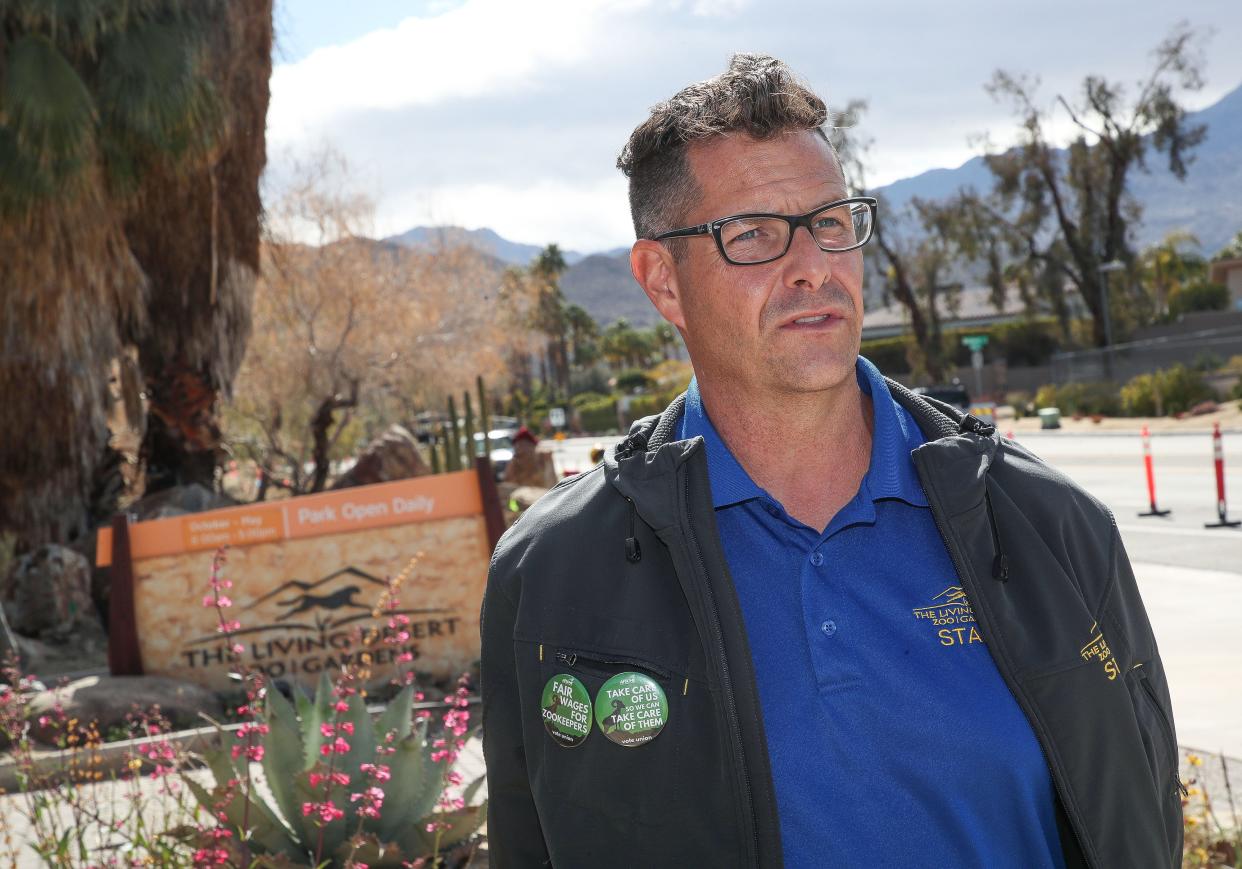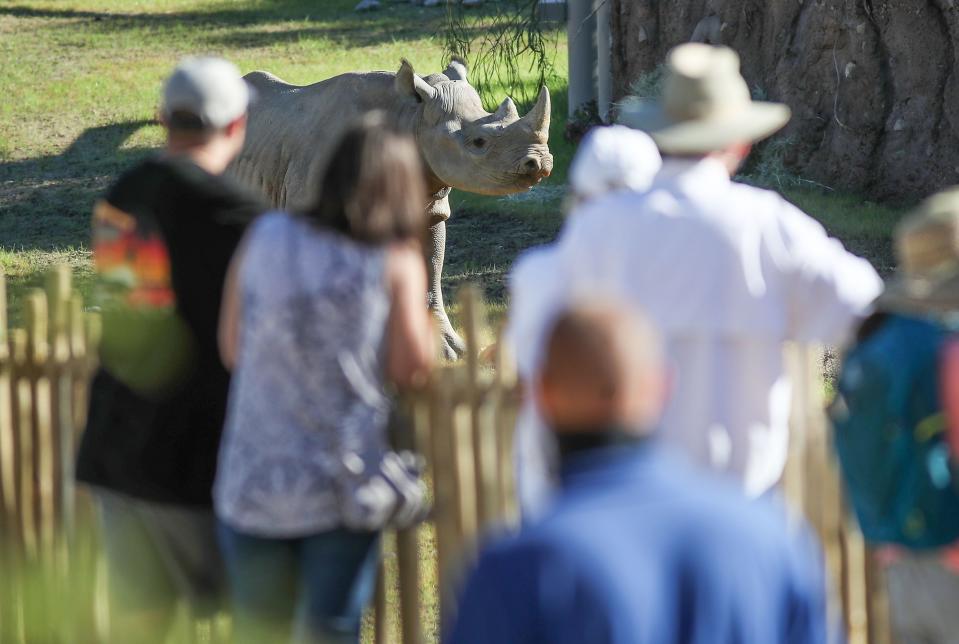Living Desert zookeepers call for higher wages amid $90M capital campaign

The Living Desert is in the midst of a $90 million capital campaign, a three-phase capital improvement project that includes a recently completed $17 million rhino habitat, and a planned $60 million lion habitat that will include a special events center with a wall of glass looking into the lions’ dens.
But zookeepers at The Living Desert say not enough of the zoo’s cash is flowing to the people who take care of those rhinos, lions, and other animals at the Palm Desert zoo. The zoo’s animal care workers voted to unionize in February, citing concerns that their wages haven’t kept up with the rising cost of living in the Coachella Valley.
“We care greatly about our animals, and we want our animals to have the best care, but it's also time that we now try to take care of ourselves. We feel that unionizing is a process for that, we've been telling management for years that we don't have the ability to afford to live here,” said Jeremy Barlow, a zookeeper at The Living Desert and a spokesperson for The Living Desert Animal Care Union’s organizing committee.
The Living Desert Animal Care Union won its election on Feb. 9, with 28 votes for the union and two votes against. The union is under the American Federation of State, County and Municipal Employees (AFSCME) District Council 36, and the new union is now meeting with legal counsel and collecting input from members before moving forward on negotiating a contract with The Living Desert, according to Barlow.
“A group of the animal care team at The Living Desert Zoo and Gardens recently voted to move forward with union representation. Although The Living Desert leadership team believes that having a direct employee relationship is best for all, the organization will now enter good faith negotiations with the animal care union. Currently, per the terms of the newly adopted process, The Living Desert leadership team is awaiting the animal care union to initiate the next steps of the negotiation process,” Living Desert President and CEO Allen Monroe said in a written statement to The Desert Sun.
Barlow works specifically with the rhino exhibit at the zoo, and describes zookeeping as a “physically, emotionally, and mentally demanding job,” with a wide range of tasks that include public speaking and educating guests, training animals, feeding and providing water to the animals, watching the up to 70 animals in the “Rhino and Friends” exhibit to keep an eye out for animals displaying aggression toward each other, and extensive record-keeping of injuries, diets, and the interactions between the animals. During the summer months, he does all of the above but in 110-plus degree temperatures ― something he says the union wants to recognize by establishing hazard pay that provides additional pay on extremely hot days.
For his efforts ― and his roughly 16 years of animal care experience ― Barlow earns $17.94 an hour.
“$17.94 in the Coachella Valley is not a liveable wage. There are many, many places that pay the same or better, that are a lot less work. I could go work at Target, or Costco, or Trader Joe’s, or a wild number of fast food restaurants and I would get paid more,” Barlow said.

According to the MIT Living Wage Calculator, which calculates “the hourly rate that an individual in a household must earn to support his or herself and their family,” the current living wage for the Riverside-San Bernardino-Ontario area is $18.66 for a single adult without children. That number jumps up with each additional family member ― for example, the living wage for a single adult with one child is $38.39, and for a two-adult household where only one adult is working the wage is $29.31.
Some zookeepers have taken on side jobs such as pet-sitting or dog-walking in order to make ends meet, according to Barlow. Noting the zoo’s capital campaign and executive compensation ― President and CEO Allen Monroe earned $518,400 in the 2022 fiscal year, according to the non-profit’s financial reports ― Barlow believes The Living Desert can afford to pay animal care workers more. In the zoo’s most recent annual report, Monroe wrote that “Attendance has reached an all-time high and has doubled in the last few years.”
“The zoo has been a little bit braggadocious about how well they’ve weathered the pandemic and how well they’ve done attendance-wise and on our capital campaign. . . The CEO and other top directors collectively earn over a million dollars for about eight or nine people. So the fact that they’re paying us basically minimum wage or what’s basically considerable minimum wage for this area is pretty pathetic,” Barlow said.
In an emailed statement to The Desert Sun, Monroe wrote, “The Living Desert has a proven history of prioritizing the well-being, health, and safety of our incredibly dedicated team members, along with the care, safety, and health of our animals. The Living Desert leadership team continues to believe that our commitment to provide an attractive and competitive compensation and benefits package is in our employees’ best interests, and supports a collaborative employee culture.”
The statement continued with a list regarding employee wages and benefits: “All employees received a 6% raise plus an up to 3% merit raise, totaling up to 9%, for the current fiscal year, effective July 1, 2022; All employees received a $5,000 bonus in June 2022; Wages are regularly adjusted based on cost-of-living assessments; A competitive benefits package includes 100% employer-covered health, dental, and vision insurance; A 401(k) plan with a 3% board-discretionary match; A generous time-off plan including 20 days of paid time off, 7 days of paid sick time, 8 days of paid jury/witness time, and 3 days of paid bereavement time.”
Barlow acknowledged that he got an 8% raise last year, but “that means my pay was even less than $17.94 before that, $17.94 is what I’m making after this raise.” The Living Desert Aimal Care Union says low wages have contributed to high employee turnover among zookeepers, with Barlow saying that after starting at the zoo about two years ago he’s now the eighth-most senior among a department of about 35.
The zoo disputes this: “The animal care team turnover rate has actually decreased in recent years. Furthermore, within the animal care department, all pre-pandemic positions have been hired back, and the number of positions within the department has increased by 7%,” wrote Monroe in a statement to The Desert Sun.
Zookeepers at several other zoos in Southern California are also unionized, including the San Diego Zoo, which Barlow says provides examples of unionized zoos that offer higher wages to their animal care workers than The Living Desert.
The San Diego Zoo declined to comment on its employee pay or retention efforts, noting it has a policy of not commenting on stories involving other zoos. Currently posted animal care positions at the San Diego Zoo list hourly wages of $22.83 and $24.29.
This article originally appeared on Palm Springs Desert Sun: Living Desert zookeepers call for higher wages amid $90M capital campaign

